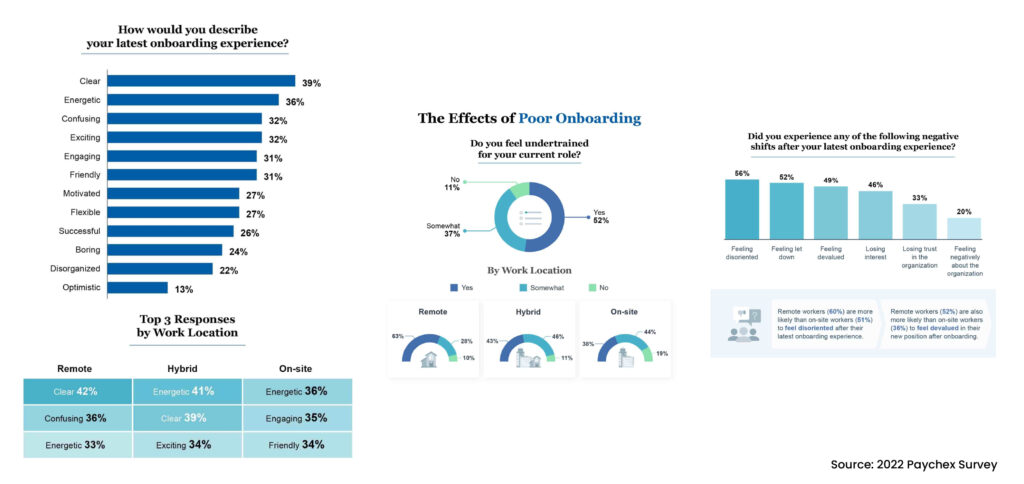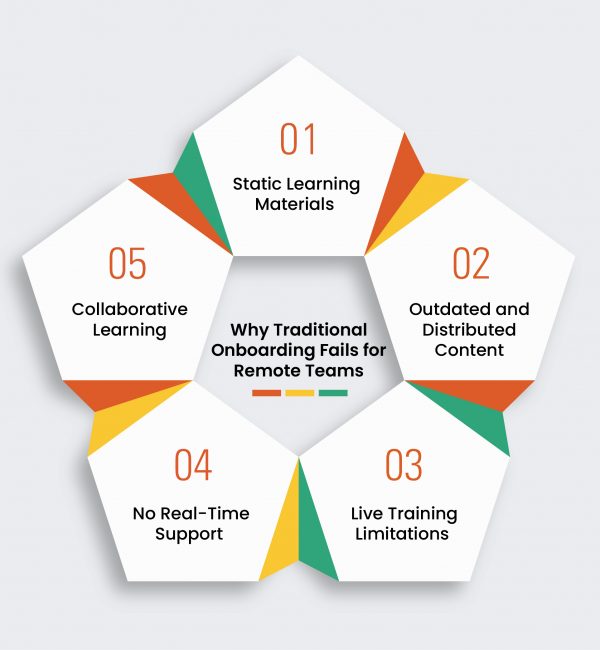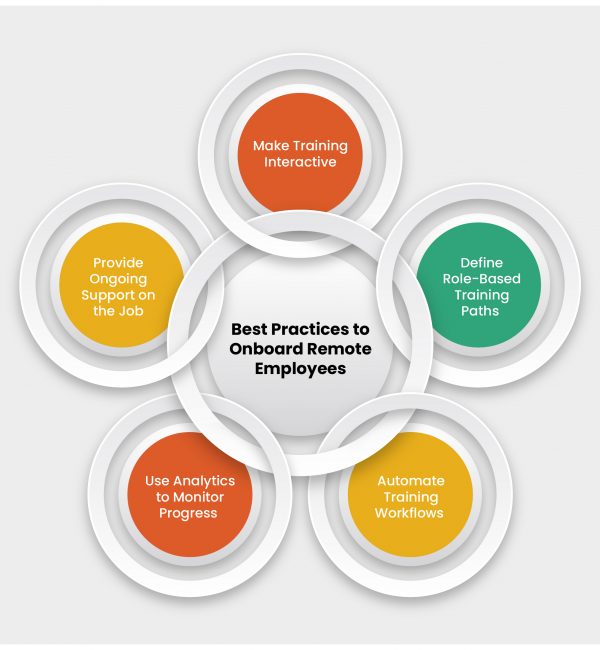Introduction
Have you ever felt that you are losing control over the recruitment of your remote workforce? Do you feel you do not have complete visibility over their training and onboarding process? You are not alone. As the corporate world shifts more towards remote and hybrid work models, this is a growing concern among leaders of many enterprises. In fact, the gap in communication during onboarding is considered a hurdle steep enough for management to hesitate to make the jump to remote training.
What they are probably missing are the right tools to bridge these gaps and overcome the remote onboarding challenges they face. Today, technology is advanced enough for digital tools to efficiently fulfill the role of instructors in classrooms or one-on-one sessions. They can even take it a step further and provide the kind of support even human trainers cannot, like 24/7 support, or handheld guidance tailored specifically to your individual needs. To stay ahead of the curve and ensure top-notch remote onboarding for your distributed team, Assima is your ultimate partner in achieving excellence.
Explore our excellent offerings for remote training and onboarding for global enterprises.
The Shift to Remote Onboarding: Challenges and Expectations
A comprehensive Paychex survey report made it clear that current organizations are not fully prepared to handle remote onboarding. If you turn your eye to some of the stats from the survey, it is clear that on-site and hybrid workers are faring better after onboarding than remote ones when it comes to user onboarding experience.

The reason for the subpar onboarding experiences of remote workers is straightforward. Common issues include:
- Lack of clear communication
- Dwindling engagement
- Knowledge gaps and miscommunications
- High time-to-productivity
- Inconsistent experiences
- Language barriers
However, with both employees, recruiters, and upper management realizing the advantages of having a distributed workforce, the dire need for a remote onboarding system capable of handling off-site training needs and resolving remote onboarding challenges is a must. With a combination of the right digital adoption solutions and proven remote onboarding best practices, you can master the process effortlessly too.
Remote Training vs Remote Onboarding
Training is the part of recruitment where a new hire is taught how to use different software for different requirements. Onboarding encapsulates acclimatizing your new colleagues to the operations of the business by providing context for every task, application, and operation. It paves the way for settling the employee into the workplace landscape so that they know what to do in any situation. Admittedly, since training and onboarding methods are different, remote training and remote onboarding are different too.
Often, even though organizations get it right when providing suitable remote training solutions to new employees, they fail to do the same with remote onboarding. The more hands-on, socially driven nature of onboarding warrants careful planning, decision-making, and implementation for remote employee onboarding tools and practices. Even with the highest quality of remote training, employees might not be able to adapt to their new workplace if remote onboarding is not done thoughtfully and sensitively.
Why Traditional Onboarding Falls Short for Remote Teams
Traditional onboarding is designed specifically for on-site teams. It cannot take on remote onboarding challenges for reasons like:
Static Learning Materials
Traditional onboarding methods mostly use static training materials like slides, manuals, and videos. They rely on in-person instructions to bring interactive dialogue into the equation. However, in the absence of human instructors, such materials fail to achieve the same results with remote onboarding.
Outdated and Distributed Content
Materials used for onboarding are often out-of-date and maintained by local teams, leading to inconsistencies and gaps in the information. Organizations also use a combination of systems to provide access to learning materials, documentation, and policies, causing confusion about where to find the right information at the right time.

Live Training Limitations
Traditional onboarding relies greatly on live training under expert supervision. However, such supervision is challenging for remote onboarding, making live training under remote circumstances fraught with risks. Scheduling and scalability are also significant limitations of live training for a remote team.
No Real-Time Support
There is also a lack of real-time support in the case of remote training using traditional onboarding techniques, in which in-person guidance and peer learning play a significant role. This can severely affect the confidence of remote employees when working on the live system without any help and result in mistakes.
Collaborative Learning
Collaborative learning in any form has been proven to be more effective than a one-directional approach. However, with remote onboarding, the scope for collaboration is limited when using traditional methods. This greatly limits the amount of knowledge retention and ideation skills of your employees.
Benefits of Interactive Training with Assima
Interactive training software like Assima is the future of remote training. If you want to tackle remote onboarding challenges head-on, here’s how we help you do it:
Hands-on Learning Experience Increases Retention
With Assima Train, you can utilize the power of a 4X patented cloning technology to create hyper-realistic clones of entire software processes that perfectly emulate the interactivity of the live system. It allows learners to get a hands-on experience of the system that boosts retention and recall.
Simulated Environments Allow Trial Without Risk
Assima simulations, despite behaving just like the live application, are completely disconnected from it and can have all the data anonymized. This allows remote workers to freely practice on them without any fear of impacting either the live system or accessing any sensitive business data on them.
Performance Support Embedded into Workflows
Assima In-App Search is your go-to solution to provide real-time, in-app guidance for training your employees. It works as an overlay widget on your live software, providing contextual, role-based information live as employees work. This helps improve performance and eliminate errors from work.
Acceleration of Time-to-Competency in Live System
By working in an accurately simulated environment and then receiving real-time guidance when working on the live system, the time-to-competency for employees is reduced by many degrees. This reduces the time required to complete remote onboarding and ensures smooth performance from the start.
Easy Updation and Maintenance of Learning Materials
Assima clones are fully editable, and every change is reflected across lessons. You do not have to add them individually to every version or re-record the entire simulation to accommodate software updates. Remote teams get access to the modified lessons instantly on being made live, ensuring consistency.
Streamlined Localization of Training for Better Understanding
Assima also allows lessons to be translated into any permitted language in a single step. You do not have to recapture the system process in the target language. Data, instructions, and the interface texts are all included in the translations. You can even dynamically switch languages in a simulation.
How can you create high-impact remote learning journeys for your workforce?
How Interactive Training and In-App Guidance Enhances the Onboarding Experience
One of the biggest hurdles faced during software onboarding for remote teams is not the poorer employee performance and retention metrics you have to deal with; it is the awful experience that recruits have that causes a decrease in motivation and loyalty. Onboarding experience is a major variable that can decide how the employee will view and interact with your company going forward. The right onboarding experience can make or break the employee’s positive attitude in the workplace as it can affect their working experience as well.
Remote onboarding challenges can be overcome easily if you can provide the right learning experience for recruits. Interactive learning modules, in-app support, and the assurance of help and collaboration when needed are all you need to give new employees a meaningful onboarding experience. If you can guarantee the human element of this experience, Assima will take care of the technological side.
Real-World Use Cases: Assima’s Impact on Remote Onboarding
Even years after implementing DxCare, Montpellier University Hospital Center (CHU) was finding it difficult to efficiently and effectively train its 13,000+-strong workforce, facing numerous challenges that its current training system could not manage. Needing a more robust and sustainable solution, they shifted to Assima. The results were overwhelming. By replacing 3 hours of classroom training with 40 minutes of distance learning, they could train hundreds of employees simultaneously and consistently and save significant money and time.
However, what was most pleasantly surprising was that not only did employees have a more fruitful experience during the re-onboarding, but they also learned more effectively. The support team of the hospital reported a sharp decline in the number of helpdesk calls when using the software after Assima was deployed. If you are interested in knowing how we did it, get more detailed insights from here.
Best Practices to Onboard Remote Employees
The right tools only work as intended when combined with the right industry practices. Here are some practices that you must adopt to expertly overcome remote onboarding challenges:
Make Training Interactive
The very principle of onboarding demands interactions. Since remote onboarding limits social interactions, you can supplement it by making digital training more interactive. Encourage trainees to participate as much as possible on the training platform and pave the path for collaboration.
Define Role-Based Training Paths
A one-size-fits-all approach hardly ever works during onboarding, if never. Every person has individual needs and responsibilities; fulfill them effectively with role-based training paths. Do not waste their time imparting knowledge that they will never need to use in their daily tasks.

Automate Training Workflows
It is impossible to provide individual attention to every recruit during onboarding unless you plan to have a 1:1 employee-to-instructor ratio, which is not feasible. Instead, automate your training workflows to determine the learning path based on the role and the progress of each trainee.
Use Analytics to Monitor Progress
Use data analytics to keep track of the progress of every learner. You will get insights into their strengths and weaknesses, how to help them, and which areas of the training program need improvement. It is the best way to optimize how employees are onboarded in your company.
Provide Ongoing Support on the Job
It is impossible for employees to become instant experts at their job right after finishing training and onboarding. This is especially true for remote workers. Ensure you provide some form of on-the-job guidance and support to them to give them time to gain confidence in their performance.
Conclusion: Future-Proofing Your Onboarding Process
Remote onboarding, like any remote process, comes with a set of unique challenges apart from those associated with the on-site version of the process. Hence, it goes without saying that you need a unique solution like Assima to deal with said challenges. Assima offers the most innovative solutions to handle remote onboarding challenges like a pro. You can do it too. Make your business ready to face a future of remote workforces with Assima!
Ace remote onboarding and create a winning remote team with Assima.
Frequently Asked Questions
Let’s Answer Some of Your Questions.
Remote onboarding refers to the process of onboarding offsite or WFH employees using digital tools to help them adjust to workplace operations and dynamics without being physically present.
Assima boasts of innovative tools and technologies developed with the aim of making remote training and onboarding for enterprises easier, faster, and smarter. Interactive training using Assima Train simulations and in-app guidance upon onboarding using Assima In-App Search helps ensure smooth onboarding for both new hires and the L&D team.
Remote teams do not have the advantage of hands-on guidance from peers or instructors when they start working on the live system as on-site employees do. They need to be supported using a tool that can provide the same level of guidance on their work terminal at their location, which is what in-app guidance provides.
Assima Train can capture screens of almost any software being used by global companies. Besides the usual enterprise software, it can easily work with homegrown applications and even legacy systems. It has a wide range of compatibility that makes it a versatile and scalable DAP option.
Interactive training is known to help knowledge retention and recall, improve problem solving skills, encourage critical thinking, and overall, boost efficiency. When an employee excels at their job and is able to get things done fast yet well while understanding perfectly what is going on, it automatically increases engagement.